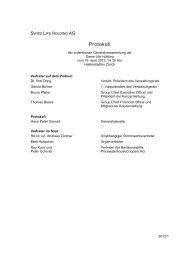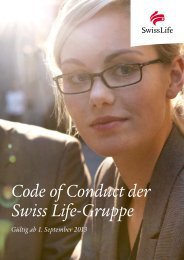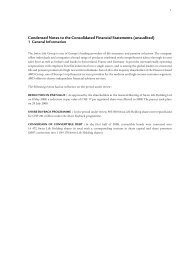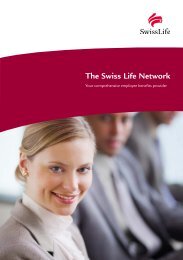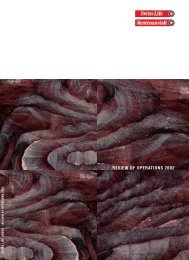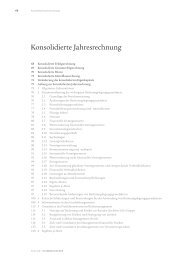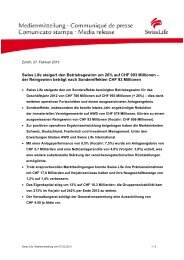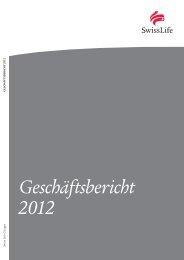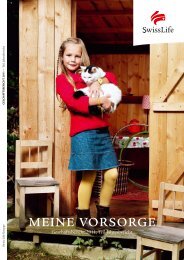Annual Report 2012 - Swiss Life
Annual Report 2012 - Swiss Life
Annual Report 2012 - Swiss Life
You also want an ePaper? Increase the reach of your titles
YUMPU automatically turns print PDFs into web optimized ePapers that Google loves.
125 Consolidated Financial Statements<br />
with the insurance component and the policy for deferred origination costs applies to the other portion<br />
(see 2.15 Intangible Assets).<br />
Administrative and surrender charges are included in policy fee income.<br />
2.11 Property and equipment<br />
Property and equipment are carried at cost less accumulated depreciation. Land is carried at cost and<br />
not depreciated. Depreciation is principally calculated using the straight-line method to allocate<br />
their cost to their residual values over the assets’ estimated useful life as follows: buildings 25 to<br />
50 years; furniture and fixtures five to ten years; computer hardware three to five years.<br />
The assets’ residual values and useful lives are reviewed, and adjusted if appropriate, at each balance<br />
sheet date.<br />
Subsequent costs are included in the asset’s carrying amount or are recognised as a separate asset, as<br />
appropriate, only when it is probable that future economic benefits associated with the item will flow<br />
to the Group and the cost of the item can be measured reliably. All other repair and maintenance<br />
costs are charged to the income statement during the financial period in which they are incurred.<br />
Borrowing costs directly attributable to the construction or acquisition of a qualifying asset are capitalised<br />
as part of the cost of that asset. Realised gains and losses on disposals are determined by<br />
comparing proceeds with the carrying amount and are included in the income statement.<br />
Property and equipment are reviewed for impairment whenever events or changes in circumstances<br />
indicate that the carrying amount may not be recoverable. An asset’s carrying amount is written<br />
down immediately to its recoverable amount if the asset’s carrying amount is greater than its estimated<br />
recoverable amount. The recoverable amount is the higher of the asset’s fair value less costs to sell and<br />
value in use.<br />
2.12 Leases<br />
Operating lease<br />
The Group primarily enters into operating leases for the rental of equipment. The total payments<br />
made under operating leases are charged to the income statement on a straight-line basis over the<br />
period of the lease.<br />
When an operating lease is terminated before the lease period has expired, any payment required to<br />
be made to the lessor by way of penalty is recognised as an expense in the period the lease becomes<br />
onerous.<br />
Finance leasE<br />
If the lease agreement transfers the risks and rewards of the assets, the lease is recorded as a finance<br />
lease and the related asset is capitalised. At inception, the asset is recognised at the lower of the present<br />
value of the minimum lease payments or fair value and is depreciated over its estimated useful life.<br />
The correspond ing finance lease obligations are recorded as liabilities.<br />
2.13 Investment management<br />
Revenue consists principally of investment management fees, commission revenue from distribution,<br />
sales of investment fund units and custody account fees. Such revenue is recognised when earned, i.e.<br />
when the services are rendered.<br />
<strong>Swiss</strong> <strong>Life</strong> – <strong>Annual</strong> <strong>Report</strong> <strong>2012</strong>



